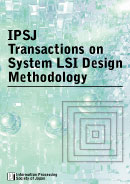Volume 7
Displaying 1-13 of 13 articles from this issue
- |<
- <
- 1
- >
- >|
-
Article type: Editorial
Subject area: Editorial
2014 Volume 7 Pages 1
Published: 2014
Released on J-STAGE: February 14, 2014
Download PDF (34K) -
Article type: Invited Paper
Subject area: Analog Circuit Design
2014 Volume 7 Pages 2-15
Published: 2014
Released on J-STAGE: February 14, 2014
Download PDF (1534K) -
Article type: Invited Paper
Subject area: Emerging Technology
2014 Volume 7 Pages 16-26
Published: 2014
Released on J-STAGE: February 14, 2014
Download PDF (1623K) -
Article type: Regular Paper
Subject area: System-Level Power Optimization
2014 Volume 7 Pages 27-36
Published: 2014
Released on J-STAGE: February 14, 2014
Download PDF (4197K) -
Article type: Regular Paper
Subject area: Behavioral Synthesis
2014 Volume 7 Pages 37-45
Published: 2014
Released on J-STAGE: February 14, 2014
Download PDF (1228K) -
Article type: Regular Paper
Subject area: Logic-Level Debugging
2014 Volume 7 Pages 46-55
Published: 2014
Released on J-STAGE: February 14, 2014
Download PDF (730K) -
Article type: Invited Paper
Subject area: Testing
2014 Volume 7 Pages 56-73
Published: 2014
Released on J-STAGE: August 04, 2014
Download PDF (2157K) -
Article type: Short Paper
Subject area: Behavioral Synthesis
2014 Volume 7 Pages 74-80
Published: 2014
Released on J-STAGE: August 04, 2014
Download PDF (611K) -
Article type: Regular Paper
Subject area: Behavioral Synthesis
2014 Volume 7 Pages 81-90
Published: 2014
Released on J-STAGE: August 04, 2014
Download PDF (1028K) -
Article type: Regular Paper
Subject area: Software Testing
2014 Volume 7 Pages 91-100
Published: 2014
Released on J-STAGE: August 04, 2014
Download PDF (407K) -
Article type: Regular Paper
Subject area: System-Level Optimization
2014 Volume 7 Pages 101-109
Published: 2014
Released on J-STAGE: August 04, 2014
Download PDF (2042K) -
Article type: Regular Paper
Subject area: Architectural Design
2014 Volume 7 Pages 110-118
Published: 2014
Released on J-STAGE: August 04, 2014
Download PDF (1618K) -
Article type: Regular Paper
Subject area: System-Level Synthesis
2014 Volume 7 Pages 119-124
Published: 2014
Released on J-STAGE: August 04, 2014
Download PDF (523K)
- |<
- <
- 1
- >
- >|
